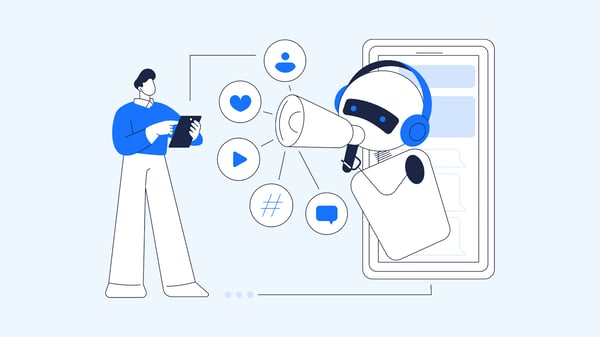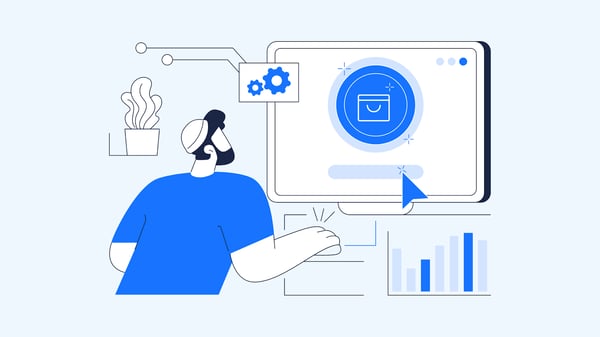May 5, 2023
 by Eric Quanstrom / May 5, 2023
by Eric Quanstrom / May 5, 2023

Identifying and implementing effective lead-generation strategies makes all the difference in the growth and success of your business.
A robust lead generation strategy ensures a predictable and consistent flow of new leads into the sales pipeline, allowing you to streamline your sales and marketing efforts and maximize return on investment (ROI). Whether you want to engage with your audience on social media, create compelling video content, or use the latest AI-based technologies, these strategies will help you drive leads and scale your business.
A lead generation strategy is a strategic approach to attracting, acquiring, and nurturing quality leads to convert them into paying customers.
Generating quality leads requires deeply understanding your target audience, their pain points, motivations, and behaviors. It's a comprehensive customer journey analysis, from initial awareness and final purchase through nurturing and retention – basically calculated steps that guide prospects through the sales funnel.
Companies with a lead generation strategy are three times more likely to achieve a higher ROI from their marketing efforts than companies without one. A clear lead generation plan pays off for your business. Here are 10 key lead-generation strategies to drive conversions and retention.
Inbound-led outbound starts by acquiring prospects through inbound marketing – creating engaging content and tracking website visitors – and then using outbound tactics – like cold calling and email campaigns – to reach them.
To implement an inbound-led outbound strategy, you need to first produce high-quality content that meets your target audience’s needs and interests. Additionally, optimize your website for search engines to attract potential customers. The better your content, the better your chances of acquiring quality leads.
The process continues further. To ensure inbound-outbound success, analyze your strategy's performance and adjust and optimize where necessary.
Artificial intelligence (AI) enabled outreach involves using AI and machine learning to track customer behavior and create targeted campaigns to engage potential leads.
AI-powered outreach can take many forms:
You free up time and resources to focus on other important tasks by automating many lead generation and nurturing processes. Plus, analyzing customer behavior with AI enables you to quickly create custom messages and content that gets the point across.
As AI advances, conversational intelligence software will inevitably become critical to lead generation.

Source: CIENCE
Personalized conversion rate optimization (CRO) customizes the customer experience and improves conversion rates. With this strategy, you create web pages tailored to your customers' needs and use automated A/B testing to optimize your conversions.
CRO personalization typically involves analyzing customer behavior and preferences to identify areas where the customer experience can be improved. For example, improving your web design, providing more relevant and personalized content, and optimizing the placement of calls to action (CTAs) on your website.
Personalized CRO gives you a head start in customer retention and satisfaction. Customers are more likely to engage with companies that offer a tailored experience. This lead generation strategy increases the likelihood of conversion and helps build trust and long-lasting customer relationships.
Events are back! And more lead-oriented than ever. Eighty percent of marketers believe live events are critical to their company’s success, and 71% say their ROI justifies investing in events.
Events can be a compelling way to drive more leads into your sales pipeline, whether in person or virtually. And they take many forms, from physical trade shows and conferences to virtual webinars and online summits. Regardless of the format, events provide a unique opportunity to connect with and build relationships with potential leads.
To use events for lead generation, first, define your goals. Would you like to generate new leads or maintain existing ones? Once you have a clear goal, you can start planning your event.
No matter what event you decide to hold, promoting and publicizing it through your marketing channels is important. Use email marketing, social media marketing, and other marketing tactics to educate your audience and get more signups.
You can also use lead capture tools and follow-up strategies like in-event email campaigns to engage with attendees. Analyze your event's performance and use those insights to optimize future events.
The term "mining" in online communities has become popular in recent years as more companies use online communities to extract information for lead generation purposes.
The key to this lead generation strategy’s success is actively participating in the community forum – answering questions, offering valuable insights, and sharing relevant information.
Here are some popular online communities:
Building relationships in these communities establishes you as a trusted authority and increases your brand's visibility. Don’t forget to stay authentic in your interactions, offering genuine insight and expertise useful in generating interest in your offering.

Source: CIENCE
Given the mass appeal of videos, it's not surprising that 91% of businesses are now incorporating video content into their marketing strategies. With usage at an all-time high, this technique can engage your audience more dynamically and visually.
Try these video formats to streamline your lead generation plan:
High-quality and visually appealing videos are engaging and informative, convey the message, and provide real value to your target audience.
When using video, remember its purpose: lead generation. Capture contact information and move potential leads down the sales funnel with clear calls-to-action and lead capture forms.
The influencer market is on the rise and is worth an estimated $21.1 billion in 2023, up 29% year over year. This indicates that more brands realize the value of using influencer marketing to generate leads and sales.
Influencer marketing can be a smart lead gen strategy for small and medium-sized businesses (SMEs) to reach new audiences. It’s an inexpensive way to promote your business if done right. Many influencers are willing to work on a performance-based model, which means you only pay them based on the number of leads or sales they generate for you.
First, identify the right influencers for your business to get started with influencer marketing. This involves some legwork to find active people in your industry or niche and analyze their followers and engagement rates to ensure they're a good fit.
Once you've identified potential influencers, develop a clear and compelling offer that will motivate them to promote your brand or offerings to their followers. This may include providing them with free products or services, a sales commission, or other incentives that align with their interests and values.
Working with the right influencers and developing a clear and compelling proposition connects you with potential customers and helps generate quality leads.

Source: CIENCE
Many companies unify customer data to generate leads. The idea is to collect data from different sources, such as customer relationship management (CRM) systems, social media platforms, and website analytics tools, to get a complete picture of the audience and their behavior.
Start by identifying the different data sources you want to bring together. This may involve working with your IT team to integrate data from different sources.
Then analyze it to gain insights about your audience. Segment your audience based on age, gender, location, or interests and use that information to develop targeted lead-generation campaigns tailored to each segment's specific preferences.
By bringing this data together, you get more insights into your ideal customer and create successful lead-generation campaigns that deliver results.
Social retargeting targets customers who engaged with your brand but didn’t take any action. This strategy involves creating targeted ads tailored to each customer's needs and interests to encourage them to complete the next step, such as purchasing or filling out a form.
Social retargeting allows you to reach customers on the platforms where they spend most of their time. You can create ads targeting the right customers using these platforms, driving lead captures and conversions.
Retargeting requires you to analyze data from your website, social media accounts, and other sources to determine which customers showed interest in your brand but didn’t take any action.
Social retargeting creates a series of touchpoints that gradually build trust and familiarity with your brand. For example, you can start with a simple reminder ad showing the product customers visited and then move on to an ad showcasing your best features or offering a discount. You can use a variety of ad formats and storytelling techniques to create a compelling narrative that motivates your audience to take action.
Dark social is a slightly different approach than traditional social media marketing. Unlike social media platforms like Facebook and Twitter, dark social channels are private messaging apps, direct messages, and native mobile apps like WhatsApp, Facebook Messenger, and Snapchat.
Dark social is all about private, one-to-one social interactions outside public social media channels. For example, if you text a friend a link to a new product you saw on a website or direct message someone on Instagram, it's all part of dark social.
Dark social bypasses the noise and competition of public social media channels. By reaching customers directly through their messaging channels, you create a closer and more personal connection, boosting trust and increasing conversions.
Of course, taking a nuanced approach when using dark social as a lead generation strategy is critical. You must respect each customer's privacy and preferences and avoid being overly aggressive or spammy with your messages.
It’s also important to encourage potential customers to take action by offering exclusive discounts or early access to new products. And don't forget to include a clear call-to-action that makes it easy for customers to take the next step: click on a link or send a message to find out more.
Effective lead generation strategies give you various tools to attract, retain, and convert prospects. To choose the right strategies for your business, consider your needs, budget, and goals. Also, regularly track your results and adjust your approach to optimize ROI.
Lead generation strategies evolve constantly. As such, staying current with the latest trends and best practices is essential. Keep an eye on new developments to create a steady flow of quality leads and thrive over the long term.
Launching a new product? Learn more about demand generation - a marketing strategy that helps you build exceptional brand awareness and generate interest in your new product or service.
Eric Quanstrom is CMO at CIENCE, responsible for growth, sales, and marketing strategies at the company. He spends his time preparing overall plans to increase revenue, reduce costs, mitigate risks, and develop programs with quantifiable objectives to measure results.
Generating leads isn’t just a priority for small businesses and startups anymore. Corporations...
 by Mehdi Hussen
by Mehdi Hussen
The pace of online learning has accelerated faster than anyone could imagine in the past...
 by Eduard Klein
by Eduard Klein
If you work in marketing, chances are you’ve heard these terms used interchangeably.
 by Alexa Drake
by Alexa Drake
Generating leads isn’t just a priority for small businesses and startups anymore. Corporations...
 by Mehdi Hussen
by Mehdi Hussen
The pace of online learning has accelerated faster than anyone could imagine in the past...
 by Eduard Klein
by Eduard Klein


